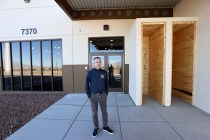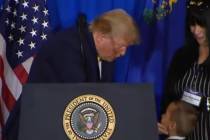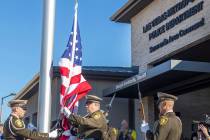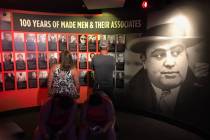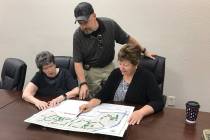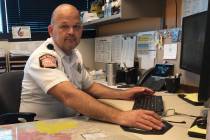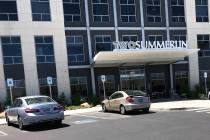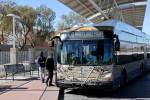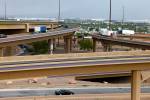Rampart, Lake Mead road construction projects benefit from fuel tax
Maybe you’re upset by the traffic, concrete barriers and inconvenience of driving along Rampart Boulevard these days and especially trying to negotiate the intersection at Lake Mead Boulevard.
Perhaps you’re seething a bit to have seen just that small portion of the Lake Mead thoroughfare being torn up only a month or two after the road had been so beautifully repaved.
And maybe your patience is running thin over the advance warnings of delays, single-lane traffic and the general mess along Rampart Boulevard, then learning that it will continue into next summer.
What may be the clincher is the recognition that you’re helping to pay for the whole thing through two new tax increases at the fuel pump just this year, totaling an additional 6.7 cents a gallon.
So what to do about it? Well, here’s some good advice: Cool it! Stay calm. What those road builders are doing is absolutely necessary. In some cases, the improvements are long overdue.
From President Obama on down, there has been a call to keep our transportation infrastructure — namely roads and bridges — from deteriorating more than they already have. The Nevada Legislature issued its own call last year when it enacted a bill — subsequently signed into law by Gov. Brian Sandoval — that created the increased fuel tax as the means to do what you’re seeing along Lake Mead and Rampart boulevards.
The Clark County Board of Commissioners played a major role by then passing an ordinance to establish fuel revenue indexing, or FRI, which ties the increased income to the rate of inflation from Jan. 1, 2014, through Dec. 31, 2016. The result is an estimated $700 million in bonding capacity to fund 199 needy transportation projects in Southern Nevada. It could also create as many as 9,400 jobs.
Once the means to the end was accomplished, the Las Vegas City Council was able to approve $12 million of FRI funds for the Rampart Boulevard project. As for Lake Mead Boulevard, that was a separate $4 million FRI project of improvements, completed in early summer. But until now, it left undone the repaving of the major intersection at Lake Mead and Rampart boulevards.
Ward 4 Las Vegas City Councilman and Deputy Mayor Stavros S. Anthony called the Rampart project “a very necessary improvement. Unfortunately, there will be inconveniences for drivers, but we’re trying to make it as accommodating as possible.”
His reference was to the work being done in phases, so that the entire Rampart project, which will include several miles of the thoroughfare, will ultimately stretch along Rampart from Lake Mead Boulevard to Alta Drive. But the work will be broken into five phases to avoid tying up traffic for so great a distance.
“It will involve the installation of a 24-inch sewer pipe, and it’s expected to take about 11 months to complete the job,” Anthony explained. Completion is expected in July 2015.
“The eventual purpose of the pipe is to bring water to a treatment facility in the vicinity of Durango Hills Golf Course,” he said. “When the Lake Mead Boulevard project was completed earlier, the intersection of Rampart and Lake Mead was left undone to avoid the necessity of redoing it.”
Funds for all FRI improvements, which include the design and construction of various transportation-related projects, are being administered through the Regional Transportation Commission of Southern Nevada.
Had both the legislation providing for the increased fuel tax and the county ordinance creating FRI not been enacted, the transportation commission would not have had the means to finance the Lake Mead and Rampart boulevard projects. In fact, the agency would have been limping along on a relatively small annual budget for construction projects.
According to a statement issued by the commission, transportation infrastructure in Southern Nevada would have suffered severely had the state and county not acted as they did.
“Without indexing, the RTC was forecasting only $22.4 million a year over the next 10 years in available funds for street and highways projects,” the statement said. That “equates to building one interchange per year, one mile of roadway per year in each jurisdiction, or one beltway segment without bridges per year.”
Herb Jaffe was an op-ed columnist and investigative reporter for most of his 39 years at the Star-Ledger of Newark, N.J. His most recent novel, “Double Play,” is now available. Contact him at hjaffe@cox.net.








